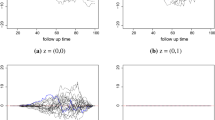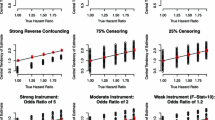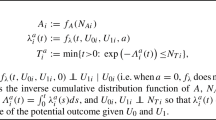Abstract
In this paper we present a framework to do estimation in a structural Cox model when there may be unobserved confounding. The model is phrased in terms of a selection bias function and a baseline model that describes how covariates affect the survival time in a scenario without exposure. In this way model congeniality is ensured. The method uses an instrumental variable. Interestingly, the formulated model turns out to have similarities to the so-called Cox–Aalen survival model for the observed data. We exploit this to enhance estimation of the unknown parameters. This also allows us to derive large sample properties of the proposed estimator.


Similar content being viewed by others
References
Aalen OO (1989) A linear regression model for the analysis of life times. Stat Med 8:907–925
Andersen PK, Borgan Ø, Gill RD, Keiding N (1993) Statistical models based on counting processes. Springer, New York
Angrist JD, Imbens GW (1994) Identification and estimation of local average treatment effects. Econometrica 62:467–475
Chen L, Lin DY, Zeng D (2010) Attributable fraction functions for censored event times. Biometrika 97:713–726
Clarke PS, Windmeijer F (2010) Identification of causal effects on binary outcomes using structural mean models. Biostatistics 11:756–70
Clarke PS, Windmeijer F (2012) Instrumental variable estimators for binary outcomes. J Am Stat Assoc 107:1638–1652
Cuzick J, Sasieni P, Myles J, Tyrer J (2007) Estimating the effect of treatment in a proportional hazards model in the presence of non-compliance and contamination. J R Stat Soc Ser B 69:565–588
Hernan MA, Robins JM (2006) Instruments for causal inference. Epidemiology 17:360–372
Kosorok MR (2008) Introduction to empirical processes and semiparametric inference. Springer, New York
Lin DY, Wei LJ, Ying Z (1993) Checking the Cox model with cumulative sums of martingale-based residuals. Biometrika 80:557–572
Loeys T, Goetghebeur E (2003) A causal proportional hazards estimator for the effect of treatment actually received in a randomized trial with all-or-nothing compliance. Biometrics 59:100–105
MacKenzie TA, Tosteson TD, Morden NE, Stukel TA, O’Malley AJ (2014) Using instrumental variables to estimate a Cox’s proportional hazards regression subject to additive confounding. Health Serv Outcomes Res Methodol 14:54–68
MacKenzie TA, Løberg M, O’Malley AJ (2016) Patient centered hazard ratio estimation using principal stratification weights: application to the NORCCAP randomized trial of colorectal cancer screening. Obs Stud 2:29–50
Martínez-Camblor P, Mackenzie T, Staiger DO, Goodney PP, O’Malley AJ (2017) Adjusting for bias introduced by instrumental variable estimation in the Cox proportional hazards model. Biostatistics 20:80–96
Martinussen T, Scheike TH (2006) Dynamic regression models for survival data, vol 102. Springer, New York
Martinussen T, Sørensen D, Vansteelandt S (2017a) Instrumental variables estimation under a structural Cox model. Biostatistics 20:65–79
Martinussen T, Vansteelandt S, Tchetgen Tchetgen EJ, Zucker DM (2017b) Instrumental variables estimation of exposure effects on a time-to-event endpoint using structural cumulative survival models. Biometrics 73(4):1140–1149
Nordestgaard BG, Palmer TM, Benn M, Zacho J, Tybjaerg-Hansen A, Davey Smith G, Timpson NJ (2012) The effect of elevated body mass index on ischemic heart disease risk: causal estimates from a mendelian randomisation approach. PLoS Med 9(5):e1001212
Richardson TS, Robins, JM (2013) Single World Intervention Graphs (SWIGs): a unification of the counterfactual and graphical approaches to causality. Technical Report 128, Center for Statistics and the Social Sciences, University of Washington
Robins J, Rotnitzky A (2004) Estimation of treatment effects in randomised trials with non-compliance and a dichotomous outcome using structural mean models. Biometrika 91:763–783
Tchetgen Tchetgen EJ, Vansteelandt S (2013) Alternative identification and inference for the effect of treatment on the treated with an instrumental variable. Harvard University Biostatistics Working Paper Series
Tchetgen Tchetgen EJ, Walter S, Vansteelandt S, Martinussen T, Glymour M (2015) Instrumental variable estimation in a survival context. Epidemiology 26:402–10
Tsiatis A (2006) Semiparametric theory and missing data. Springer, New York
Vansteelandt S, Goetghebeur E (2003) Causal inference with generalized structural mean models. J R Stat Soc Ser B 65:817–835
Vansteelandt S, Bowden J, Babanezhad M, Goetghebeur E (2011) On instrumental variables estimation of causal odds ratios. Stat Sci 26:403–422
Acknowledgements
We are grateful to Shoaib Afzal and Børge Nordestgaard for giving us access to the CGPS-data.
Author information
Authors and Affiliations
Corresponding author
Additional information
Publisher's Note
Springer Nature remains neutral with regard to jurisdictional claims in published maps and institutional affiliations.
Appendix: Large sample properties
Appendix: Large sample properties
Large sample properties of the estimator of A
The consistency of \({{\hat{A}}}(t, \phi _0)\) may be shown similar to what is done in Martinussen et al. (2017b). We will here focus on the asymptotic distribution of \({{\hat{A}}}(t, \phi _0)\). To this end, define the \(p \times n\) matrix H as
for \(p=k+2\) and k the dimension of C. Then we can write
Notice that we can write the true nuisance parameter \(A_0\) as
Now \(n^{1/2}\{{{\hat{A}}} (t, \phi _0)-A_0(t)\}\) can be expressed as
First we take a closer look at the last integral in this expression. By a Taylor approximation we have
where V is the \(p\times p\) matrix
As H only depends on the first element of \(A_0\) namely \(B_X^0\) then the first column of V is non-zero and the rest consist of zeros. Define \( Z(t, \phi _0) = n^{1/2}\{{{\hat{A}}} (t, \phi _0)-A_0(t)\}^T\) and from the above calculations we see that it satisfies the following Volterra equation (Andersen et al. 1993, p. 91)
and the solution is
where \({\mathcal {Q}}\) is the product integral

as defined in Andersen et al. (1993). Finally, we have that
In this expression \([n^{-1}Y\{s, \phi _0, B^0_X(s-)\}^TW(s)Y\{s, \phi _0, B^0_X(s-)\}]^{-1}\) converges in probability to some \(p\times p\) matrix that we denote \(l_1(s)\). Also \({\mathcal {Q}}(s, t)^T\) converges to some limit in probability that is denoted l(s, t). Further, one can show the convergence in distribution of \(n^{-1/2}Y\{s, \phi _0, B^0_X(s-)\}^TW(s) d M(s)\) to a mean zero process. Then we have the i.i.d. representation of \({{\hat{A}}}(t, \phi _0)\)
with
where the elements of \(\epsilon _i^A\) are denoted \((\epsilon _i^{B_X}, \epsilon _i^{\varOmega _C}, \epsilon _i^{\varOmega _0})^T\). This representation ensures convergence of the finite dimensional distribution. Convergence in distribution as a process can be shown similarly to what is done in Martinussen et al. (2017b).
Large sample properties of \({{\hat{\psi }}}\)
We first note that
so
and since we have assumed \({{\hat{\theta }}}\) to be RAL we just need to find the asymptotic distribution of \(n^{-1/2}U(\phi _0)\). We can write this function as
The first term on the right hand side of the latter display is the martingale
Note that \(Y \{t, \phi _0, {{\hat{B}}}_X(t-)\}\) and \(Y \{t, \phi _0,B^0_X(t)\}\) share all entries except for the first column. If we let \(Y_{*1}\) denote the first column of Y then (15) can be written as
Using a Taylor expansion this is asymptotically equivalent to
Let \(d_{B_X}(t)\) denote the limit in probability of the derivative \(n^{-1}\frac{\partial X^T Y_{*1}\{t, \phi _0,B^0_X(t)\}}{\partial B_X^0(t)}\). By the i.i.d. representation of \(n^{1/2}\{{{\hat{B}}}_X(t-)-B_X^0(t)\}\) derived earlier in this Appendix, (15) is seen to be asymptotically equivalent to the following sum of zero-mean i.i.d. terms
For the latter of these integrals, (14), we have convergence in distribution of its integrand \(n^{1/2}\{{{\hat{A}}}(t, \phi _0)-A_0(t)\}\) and the integral can be written as (Kosorok 2008, Lemma 4.2)
since \(n^{-1}[X^TY\{t, \phi _0, {{\hat{B}}}_X(t-)\}-X^TY\{t, \phi _0,B^0_X(t)\}]\) converges in probability to 0. Denote the limit in probability of \(n^{-1}X^TY\{t, \phi _0, B_X^0(t)\}\) as \(l_{XY}(t)\). Thus it is asymptotically equivalent to
Finally, we have that \(n^{-1/2} U(\psi _0) = n^{-1/2}\sum _{i=1}^n\epsilon ^U_i+o_p(1)\), where
Finally,
where
with \({{{\mathcal {J}}}}_{\psi }\) denotes the limit in probability of \(n^{-1}D_{\psi }U\) and similarly with \({{{\mathcal {J}}}}_{\theta }\). Based on the above derivations, the i.i.d. decomposition of \(n^{1/2} \{ {{\hat{A}}}(t, {{\hat{\phi }}})-A_0(t)\}\) can easily be obtained since
where \(D_{\psi } {{\hat{A}}}(t, \psi _0)\) converges in probability to some limit as \(n\rightarrow \infty \). Hence also,
where
with \( {{{\mathcal {A}}}}_{\psi }\) denoting the limit in probability of \(D_{\psi } {{\hat{A}}}(t, \phi _0)\), and similarly with \( \mathcal{A}_{\theta }\).
Rights and permissions
About this article
Cite this article
Sørensen, D.N., Martinussen, T. & Tchetgen Tchetgen, E. A causal proportional hazards estimator under homogeneous or heterogeneous selection in an IV setting. Lifetime Data Anal 25, 639–659 (2019). https://doi.org/10.1007/s10985-019-09476-y
Received:
Accepted:
Published:
Issue Date:
DOI: https://doi.org/10.1007/s10985-019-09476-y




